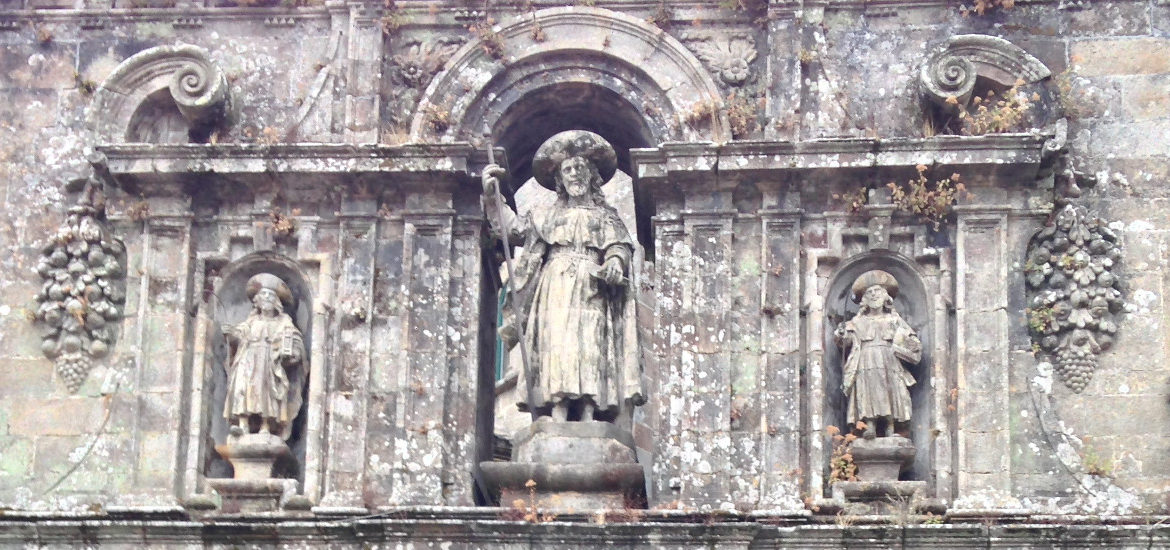Fisterra
Day 32, Tuesday 24 September 2013
Give me my scallop shell of quiet;
My staff of faith to walk upon;
My scrip of joy, immortal diet;
My bottle of salvation;
My gown of glory (hope’s true gage)
And then I’ll take my pilgrimage.
– Sir Walter Raleigh
It was the last day of our stay in Fisterra (Finisterre). It was also the last day of our pilgrimage. It was cloudy and drizzly and the weather was a reflection of my feelings. I felt sad because of Raymond. This journey was inspired and dedicated to him. I felt gratitude that I was able to complete the journey that might contribute to closure. On the long, isolated road I had no choice but to think. I realised that this was not only a physical journey but spiritual and emotional. For me it was more emotional on certain days. Our 811 km journey from St Jean Pied de Port to Santiago de Compostela was prodigious.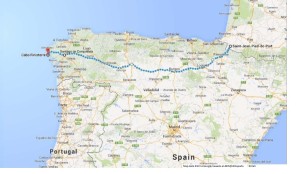
When we started our journey in St Jean Pied de Port, we received the scallop shell in exchange for a donation. The scallop shell is one of the iconic symbols of the Camino de Santiago. The yellow and blue scallop sign is used to show direction to the pilgrims walking to Santiago de Compostela along the many different routes. It is painted on trees, sidewalks, buildings, etc, to help pilgrims find their way.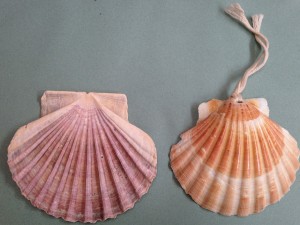 I picked up this scallop shell (left) on the beach at Fisterra and the shell (right) was received at St Jean Pied de Port and carried all the way to Santiago de Compostela. Pilgrims carried this scallop as a token, just as medieval pilgrims wore a scallop shell attached to their cloaks or hats during their journey to Santiago. The scallop shells also had a practical purpose then, they were used for a bowl so the pilgrims could use them to hold their food and drink on their long journey. Pilgrims would also be given food at churches and a scallop shell scoop was the measure for the food they would be donated. There are many stories, legends and myths that try to explain the ancient link between the scallop shell and the Saint James Way. The scallop shell is said to be a metaphor, its lines representing the different routes pilgrims travelled from all over the world, all walking trails leading to one point: the tomb of Saint James in Santiago de Compostela. The scallop shell might originally be a pagan symbol of fertility. The shape of the scallop shell also resembles the setting sun, which would have been an important daily event, full of symbolism in pre-Christian societies. It is probably not just a mere coincidence that the Saint James Way is a journey to the West, finishing at the ‘end of the world’ (the name given to Fisterra) and the setting sun. A legend about the scallop shell is that after James’ death, his disciples shipped his body to the Iberian Peninsula to be buried in what is now Santiago. Off the coast of Spain, a heavy storm hit the ship, and the body was lost to the ocean. After some time, however, it washed ashore undamaged, covered in scallops.
I picked up this scallop shell (left) on the beach at Fisterra and the shell (right) was received at St Jean Pied de Port and carried all the way to Santiago de Compostela. Pilgrims carried this scallop as a token, just as medieval pilgrims wore a scallop shell attached to their cloaks or hats during their journey to Santiago. The scallop shells also had a practical purpose then, they were used for a bowl so the pilgrims could use them to hold their food and drink on their long journey. Pilgrims would also be given food at churches and a scallop shell scoop was the measure for the food they would be donated. There are many stories, legends and myths that try to explain the ancient link between the scallop shell and the Saint James Way. The scallop shell is said to be a metaphor, its lines representing the different routes pilgrims travelled from all over the world, all walking trails leading to one point: the tomb of Saint James in Santiago de Compostela. The scallop shell might originally be a pagan symbol of fertility. The shape of the scallop shell also resembles the setting sun, which would have been an important daily event, full of symbolism in pre-Christian societies. It is probably not just a mere coincidence that the Saint James Way is a journey to the West, finishing at the ‘end of the world’ (the name given to Fisterra) and the setting sun. A legend about the scallop shell is that after James’ death, his disciples shipped his body to the Iberian Peninsula to be buried in what is now Santiago. Off the coast of Spain, a heavy storm hit the ship, and the body was lost to the ocean. After some time, however, it washed ashore undamaged, covered in scallops.
The scallop was native to the coast of Galicia and the shell became a memento, a physical proof of having completed the pilgrimage to Santiago and could be picked up at the end of the journey in Fisterra as a souvenir.
We went down to the beach although it drizzled. I took soil from Raymond’s grave and left it on certain places on the Camino where I felt the need to do so. To close the circle according to the custom of the pilgrimage, I had to bring something back. I collected a few scallop shells the previous day, but I picked up too many and put some back on the beach as a token of farewell and completion of this journey.
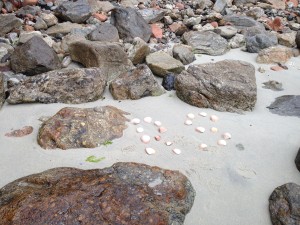 The day Raymond was diagnosed changed our lives forever. I felt I was falling into a deep, dark void. We prayed, we asked for a miracle, we explored all the possible medical options, in vain. After his death in 2005, everything I believed in seemed irrelevant. I was angry with God for taking Raymond. Did God exist? Did Jesus walk on this earth? Why did we believe, why did we pray, why did we have hope? I was disappointed in the church and the hypocrisy from some people who act with that label, being from the church, pretended to care. For years I struggled with faith. I read books, seek confirmation of God’s existence everywhere and lived in a spiritual and religious emptiness. Confused and disheartened, because the foundation of my faith was doubted. For years, walking the Camino was a consideration that I never thought would actually happen.
The day Raymond was diagnosed changed our lives forever. I felt I was falling into a deep, dark void. We prayed, we asked for a miracle, we explored all the possible medical options, in vain. After his death in 2005, everything I believed in seemed irrelevant. I was angry with God for taking Raymond. Did God exist? Did Jesus walk on this earth? Why did we believe, why did we pray, why did we have hope? I was disappointed in the church and the hypocrisy from some people who act with that label, being from the church, pretended to care. For years I struggled with faith. I read books, seek confirmation of God’s existence everywhere and lived in a spiritual and religious emptiness. Confused and disheartened, because the foundation of my faith was doubted. For years, walking the Camino was a consideration that I never thought would actually happen.
On the Camino, I saw trees, mountains and vast open fields. I walked in coolness of the morning and sometimes rain, I walked in the heat, over mountains, through open fields, farmlands, wheat fields, vineyards, over rivers, streams. I realised that I had to forgive. I walked for days thinking about forgiveness. I had unconditionally to forgive God, the people I thought did me wrong, I had to forgive myself for what I wronged. It was like leaving things behind by revisiting it, got to terms with it and let it go. In the weeks walking on the Camino I got rid of some of the excessive inner baggage, just as we got rid of the excessive baggage in our backpacks. Walking thereafter was easier and gratifying. Still, I was not under the illusion that life was now perfect, I was changed in a way and I was able to travel lighter, possibly more capable to cope with life than before. But Raymond, I cannot help to be sad when thinking of you and I know that this would never change. I might be able to live and cope better after this journey.
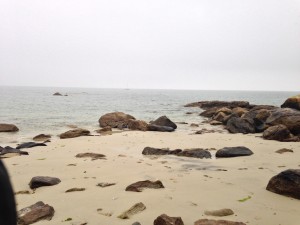 The rain shortened our visit to the beach. We went back, gathered our belongings and went to the bus stop. While queuing there, it was interesting to watch the people also waiting for the bus. Some of them were dressed like bohemian gypsies and hippies among the normally dressed travellers.
The rain shortened our visit to the beach. We went back, gathered our belongings and went to the bus stop. While queuing there, it was interesting to watch the people also waiting for the bus. Some of them were dressed like bohemian gypsies and hippies among the normally dressed travellers.
Back in Santiago de Compostela we stayed in the same Area Central Hotel. We revisit some of the places near the cathedral, the tapas bar with the delicious patata bravas and did some souvenir shopping.
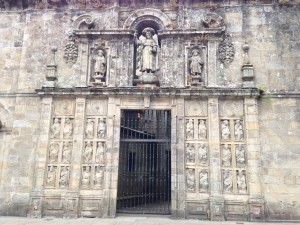 The Plaza de la Quintana faces one of facades of Santiago cathedral. The buildings that line this plaza are the cathedral, a monastery called the Monasterio de Antealtares that is the city’s second oldest building and a palatial structure called the Casa de la Parra. The Plaza de la Quintana also provides a view of the Portico Real (Royal Door) of the cathedral that is only opened during one of Santiago’s holy years.
The Plaza de la Quintana faces one of facades of Santiago cathedral. The buildings that line this plaza are the cathedral, a monastery called the Monasterio de Antealtares that is the city’s second oldest building and a palatial structure called the Casa de la Parra. The Plaza de la Quintana also provides a view of the Portico Real (Royal Door) of the cathedral that is only opened during one of Santiago’s holy years.
The Plaza de las Platerias a is a smaller square, which is surrounded by splendid examples of Galician architecture and featuring an ornate fountain at its centre (the fountain of horses). This plaza also has a wide stone stair at one end and is overlooked by two impressive buildings, the Bank of Spain and the Chapter house building.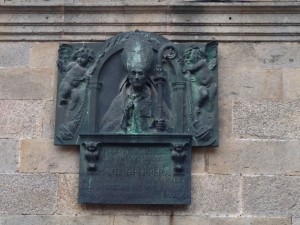
The next morning we bid farewell to Santiago de Compostela and took the train to Porto. We stayed over in Porto on our way to Lisbon where I had to get the flight back to South Africa.
